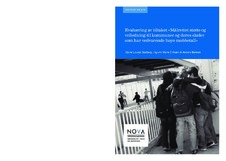| dc.contributor.author | Seeberg, Marie Louise | |
| dc.contributor.author | Eriksen, Ingunn Marie | |
| dc.contributor.author | Bakken, Anders | |
| dc.date.accessioned | 2020-06-07T21:06:13Z | |
| dc.date.accessioned | 2021-04-29T13:53:16Z | |
| dc.date.available | 2020-06-07T21:06:13Z | |
| dc.date.available | 2021-04-29T13:53:16Z | |
| dc.date.issued | 2015 | |
| dc.identifier.isbn | 978-82-7894-542-1 | |
| dc.identifier.issn | 0808-5013 | |
| dc.identifier.uri | https://hdl.handle.net/20.500.12199/3450 | |
| dc.description.abstract | An estimated 12% of primary and lower secondary schools in Norway have struggled with bullying over a longer period of time, according to the annual Pupil Survey. The Norwegian Directorate for Education and Training has instigated a pilot project offering guidance and support to some of these schools. NOVA has assessed the pilot, based on interviews with the project leader, the guidance teams, school owners, leaders and teachers at three schools, as well as analyses of central documents and an analysis of changes of bullying statistics based on data from the Pupil Survey. The study is financed by The Norwegian Directorate for Education and Training. The pilot project was conducted by the Norwegian Centre for Learning Environment and Behavioral Research in Education (Læringsmiljøsenteret), and its aims were 1) to develop schools’ learning environment in order to prevent and reduce bullying and 2) to aid school officials in creating appropriate systems and routines for bullying prevention and reduction. This report investigates how the project has been implemented and experienced and whether it has reached the goals. We found that the process of selecting participant schools was unclear, and school leaders and school owners (municipalities) experienced the process as problematic and partly unjust. Leading to confusion and resistance to participate, this was one of the main hindrances for a more positive outcome of the measure. The confusion has in some cases led to considerably more work, and to the need for different approaches at different schools. The guidance teams consisted of participants with different approaches, on the one hand those focusing strictly on bullying and on the other hand participants employing a broader focus on the learning environment. The way the measure has been implemented has differed greatly partly due to the guidance teams’ different approaches and partly because of the participant schools’ different attitudes and self-understanding. The measure is regarded differently by people in different roles. The school leaders see it as positive, but also as a potential threat to the legitimacy of their role as school leaders. The teachers find the measure as a whole marginal to their daily tasks, the tools useful and the lasting impact on the school small. The pupils in general do not know about the measure. It is too early to conclude whether the pilot project has reached its goals. It is also difficult to separate any effects of this particular measure from other ongoing processes in schools and municipalities. The analysis of the Pupil Survey indicates that it is not possible to verify any tendency to reduced bullying in the participant schools. Recommendations: That the process of selecting schools for participation be reviewed and made more transparent, and that closer attention be paid to local knowledge and communication in the selection of participant schools That more time and effort be spent on school development and anchoring and legitimising the project locally That the time frame of the measure be expanded or that a different model be used, e.g. utilising an ambulant guidance team that may be used when necessary That a progression plan be made compulsory for the schools without this being added as extra bureaucracy, but rather as an agreement on real and realistic milestones with interim reflection on the process for possible adjustments of the work plan That in the focus be moved from experts and leadership to the classroom and that teachers and pupils work together under guidance for a better school environment, at the same time as the school leaders and -owners maintain their ownership and responsibility That time is allocated for discussions about the main focus of the project in order to deal explicitly with the tension between proponents of the ‘bullying focus’ and the ‘learning environment focus’. Discussions should take place centrally as well as in each municipality and school. | en |
| dc.description.abstract | Rapporten er en evaluering av tiltaket «Målrettet støtte og veiledning til kommuner og deres skoler som har vedvarende høye mobbetall.» Målet med tiltaket er å hjelpe skoler til å utvikle læringsmiljøet på skolene slik at de blir i stand til å forebygge og redusere mobbing. Rapporten konkluderer med at det er vanskelig å påvise at det har blitt mindre mobbing på de skolene som har vært med i pilotprosjektet. Videre har utvalgskriteriene av skoler vært uklare, noe som har vært en av årsakene til manglende forankring av tiltaket ved skolene. NOVA anbefaler bl.a. at måten skolene plukkes ut på, vurderes på nytt, at det legges større vekt på lokal kunnskap om faktiske problemer og prosesser, at det i neste runde brukes mer tid på lokal implementering, forankring og skoleutvikling, at det innføres mer forpliktende progresjon ved skolene, og at fokus i sterkere grad skyves fra eksperter og ledelse til klasserommet. | no_NB |
| dc.publisher | Oslo Metropolitan University - OsloMet: NOVA | |
| dc.relation.ispartofseries | NOVA Rapport 3/15 | |
| dc.subject | NOVA--School--Youth | |
| dc.title | Evaluering av tiltaket «Målrettet støtte og veiledning til kommuner og deres skoler som har vedvarende høye mobbetall» | no_NB |
| dc.type | Report | |
| fagarkivet.author.link | https://www.oslomet.no/om/ansatt/abakk | |
| fagarkivet.source.pagenumber | 89 | |
